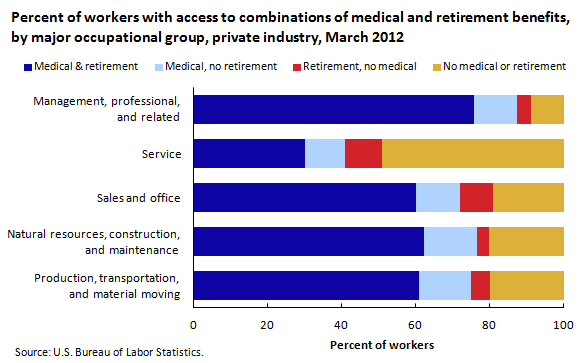An official website of the United States government
 United States Department of Labor
United States Department of Labor
More than three-quarters (76 percent) of workers in management, professional and related occupations had access to both retirement and medical benefits in March 2012, and only 9 percent had access to neither benefit. In the service occupations, by contrast, only 30 percent had access to both benefits and 49 percent had access to neither benefit. In each of the three other major occupational groups—sales and office; natural resources, construction, and maintenance; and production, transportation, and material moving—at least 60 percent of workers had access to both medical and retirement benefits.

| Occupation | Medical and retirement | Medical, no retirement | Retirement, no medical | No medical or retirement |
|---|---|---|---|---|
Management, professional, and related | 76 | 12 | 4 | 9 |
Service | 30 | 11 | 10 | 49 |
Sales and office | 60 | 12 | 9 | 19 |
Natural resources, construction, and maintenance | 62 | 14 | 3 | 20 |
Production, transportation, and material moving | 61 | 14 | 5 | 20 |
Workers in the highest 25‑percent average wage category had greater access to combinations of both medical and retirement benefits than workers in the three lower wage categories. More than four-fifths (82 percent) of workers in the highest wage category were offered some combination of the two benefits, and only 5 percent of these workers reported having no access to either benefit. Workers in the lowest 25‑percent wage category had the lowest rate (24 percent) of access to these benefits and were actually more likely to be offered neither benefit (51 percent).
These data are from the National Compensation Survey program. To learn more, see “Retirement and medical benefits: Who has both?” (HTML) (PDF), by Lindsay B. Kimbro and Michelle B. Mayfield, Beyond the Numbers, April 2013.
Bureau of Labor Statistics, U.S. Department of Labor, The Economics Daily, Medical and retirement benefits, March 2012 at https://www.bls.gov/opub/ted/2013/ted_20130426.htm (visited January 19, 2026).

